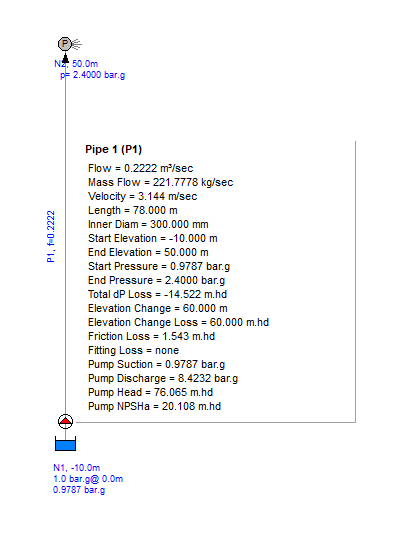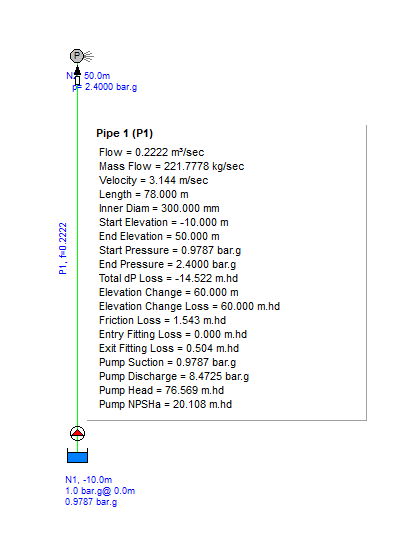How does Pipe Flow Expert account for a velocity head (Dynamic Pressure) when a fluid discharges?
Pressures: Static Pressure versus Stagnation Pressure
(and accounting for dynamic pressure due to fluid velocity)
- Static Pressure is the pressure a fluid would exert on its surroundings if it was not moving.
- Dynamic Pressure, also known as velocity pressure, is the pressure caused by the velocity of the fluid.
- Stagnation Pressure is the Total Pressure, which is the Static Pressure plus the Dynamic Pressure.
In Pipe Flow Expert, a Tank acts as an infinite reservoir of fluid which is considered to be at rest, with zero fluid velocity. When a fluid is at rest, the Total Pressure (Stagnation Pressure) and Static Pressure are equal since there is no dynamic pressure because the fluid velocity is zero.
When a liquid starts to move through a pipe with velocity, some of the pressure is converted to dynamic (velocity) pressure and hence the static pressure in the pipe is reduced (by the velocity pressure).
In Pipe Flow Expert, boundary pressure conditions as defined by Tanks or End Pressures are Static Pressures that do not include any dynamic pressure due to fluid velocity. In order to account for the velocity pressure at a discharge point, an ‘exit’ fitting must be included to produce a pressure loss that is equivalent to the velocity pressure. The point immediately before the exit fitting then represents the Total Pressure including the velocity head (Static discharge pressure + Dynamic pressure due to fluid velocity).
There is an ‘Open Pipe Exit’ fitting (exit to atmosphere for example) that has a K factor of 1, and this can be used to 'add on' the dynamic velocity pressure to the static end pressure, to give the total pressure at the point prior to the exit fitting. The loss through the exit fitting is calculated as kv^2/2g = 1*v^2/2g = v^2/2g which is the dynamic velocity pressure in head of fluid.
It is the difference in pressure, from pressure at a point upstream, to the total pressure at point of discharge that determines the flow rate that will occur, hence why it is necessary to include an exit fitting to get the total pressure including velocity head at the point immediately before discharge.
If we take a discharge to atmosphere for example, we can use an End Pressure node in Pipe Flow Expert and set this to 0 bar.g. Here the static atmospheric pressure is 0 bar.g however the fluid flows out of the end of the pipe with some velocity (dynamic pressure) and therefore we also include an exit fittting with a k factor of 1 to account for this velocity pressure, making the point prior to the exit fitting equal the Total Pressure including the velocity pressure.

In the model we include an exit fitting with a k factor of 1 (as explained in Crane technical paper 410). The loss through this fitting essentially represents the dynamic pressure of flowing fluid.
i.e. you can think of it as the software using the Exit fitting to ‘calculate’ what the Stagnation Pressure (Total Pressure) would be immediately prior to the exit fitting, since this is the static pressure plus the dynamic fluid pressure.
If you want to specify a static pressure to discharge against like in the case of a discharge to atmosphere or into some container, then you need to include an exit fitting to account for velocity head as explained in the above notes.
Note:
When considering the overall operation of a piping system, the distinction between total and static pressures may not be significant. For most liquid applications, the fluid velocities are generally relatively low to minimize the amount of friction loss and this results in only small amounts of dynamic fluid energy, which means the difference between the total and static pressures if often not significant when measuring these on many industrial pressure gauges. Of course, you need to decide whether this is or is not significant in your particular system.
Example:
Take this simple system where water is pumped vertically from 10m underground and exits the pipe at an elevation of 50m.
Model 1 does not include the exit fitting and therefore the 2.4 bar.g pressure specified represents the total pressure. The pump head in this system is calculated to be 76.065m hd.
If we add an Exit fitting with a k factor of 1 on to the end of the discharge pipe, as in the Model 2, then the loss through the Exit fitting, i.e. the dynamic fluid pressure, when the velocity is 3.14 m/sec, will be v^2/2g = 3.14^2/(2*9.81) = 0.5025 m hd, which means the pump will need to overcome this extra loss (it needs to generate additonal head to account for the velocity head pressure).
Adding the exit fitting causes the calculated pump head to increase to 76.569 m hd.
Model 1:

Model 2:








